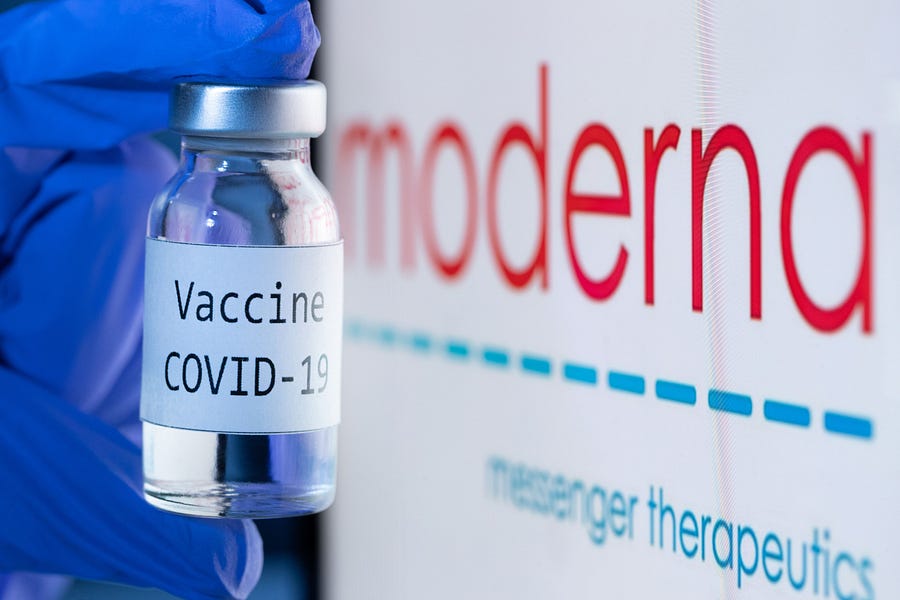Amid all the grim news about the pandemic, Americans finally have some cause for optimism. Over the past 10 days, Pfizer and Moderna have announced that analyses of the Phase III trials for their respective vaccine candidates show they are remarkably effective in preventing the infection. Pfizer announced last Monday that early analysis showed an efficacy rate of 90 percent for its vaccine, and the company has since announced the rate is closer to 95 percent. In the interim, Moderna announced that its vaccine demonstrated 94.5 percent efficacy in its trial.
Moderna’s results were based on a 30,000 patient study. There were 95 cases of infection among patients who received a placebo, compared to only five cases in those who received the vaccine. Pfizer’s final review was conducted after 170 COVID cases had been confirmed, with 162 in the placebo, and eight in the treatment arm. Pfizer is preparing to file for FDA approval, and in the best-case scenario, the first doses of the vaccine could be ready for distribution as early as this December.
Given that vaccine development generally takes several years, these accomplishments are impressive. And the success can be attributed to a number of factors: The government preordered a large number of doses through Operation Warp Speed, and the Gates Foundation funded the efforts of both Pfizer and Moderna.
But another major reason for the rapid progress was a new approach to vaccine design. It’s not a coincidence that Pfizer and Moderna saw similar results in their trials: Both vaccines are based on messenger RNA (mRNA for short). While mRNA vaccines have many advantages compared with standard vaccines, there are some drawbacks that may limit how quickly and efficiently the vaccine gets distributed to the public.
Traditional vaccines work by introducing either the actual virus, or part of it, into the body to “trick” the body into thinking it’s being invaded by the virus and induce an immune response. To avoid actually causing disease, the virus is either attenuated (weakened) as in MMR vaccines, or inactivated (killed), as in the influenza vaccine. Another strategy is to use only a piece (subunit) of the virus, such as in the shingles vaccine.
Manufacturing these vaccines, however, requires growing the virus in large quantities (in chicken eggs for flu vaccines, for example). The process takes months, which slows down the development and mass production of the vaccine. That, plus the nonzero risk of developing disease-like side effects, is not ideal during a raging pandemic.
The two mRNA vaccines, however, don’t use an actual virus at all. Messenger RNA includes instructions for cells to assemble proteins and can be synthesized in about a week, using available genetic technology and the known genetic sequence of the virus. In the case of the COVID-19 vaccine, the mRNA used is a copy of the part of the viral RNA that contains assembly instructions for the “spike protein” that gave coronaviruses their name (“corona” means “crown”). That spike protein is also what the virus uses to bind to and invade cells. (This video illustrates how the mRNA vaccines work.) The vaccine is delivered by intramuscular injection. The muscle cells take up the mRNA, and themselves produce viral proteins that induce an immune response and the production of antibodies. Those antibodies should then work to fend off infection if the patient is exposed to the actual virus.
Since only part of the virus is replicated, and that can’t cause disease by itself, this strategy eliminates any risk that a “bad batch” of a whole virus vaccine could actually cause disease, as occurred during the early rollout of polio vaccine.
A theoretical advantage of mRNA vaccines is that they result in the patient’s own cells containing apparent parts of the virus. So, much as in a natural viral infection, they may induce T-cell immunity as well immunity from antibodies. T-cells are white blood cells that fight infection: Some can recognize and kill off the infected cells, while others can help antibody-producing B cells to recognize and mount a response. In addition to contributing to the overall immune response, T-cell immunity may last longer than the immunity from antibodies alone.
One question that will take more time to answer is exactly how long the immunity induced by the vaccine will actually protect patients against the virus. Partially because of this, both the Pfizer and Moderna vaccines use a two-shot protocol, which may result in lower compliance than a one-shot regimen. It remains to be seen if the vaccine’s protective effects will last even one year, which is the usual threshold for a vaccine to be licensed.
Also of note, Moderna has released data that there were 11 cases of severe COVID symptoms among those who contracted the disease in the placebo group — but zero in the vaccinated group. Pfizer’s report of final data analysis included information that there were nine cases of severe COVID symptoms in the placebo group but only one such case in the vaccinated group.
This means that both vaccines may, much as the influenza vaccine, provide partial immunity even if they don’t fully prevent infection. Patients who are infected despite getting the vaccine might see enough of a boost to the immune system to turn what would otherwise be a severe infection to a moderate or mild one. While not optimal, such a response would still reduce hospitalizations and deaths.
Another concern, as with any vaccine, is side effects; per a prior report from a Phase I trial (a small trial meant to primarily test a vaccine for safety), some participants reported fever, fatigue, headache, chills, muscle and joint pains, as well as redness and swelling at the injection site. Symptoms mostly peaked by the second day after vaccination and resolved by the one-week mark. These effects were milder in older participants.
While that sounds good, it could also suggest that the vaccine could also be weaker in terms of efficacy in older people. Subgroup analyses of the Phase III Pfizer trial are yet to be released. However, the more detailed results released on Wednesday indicated that the vaccine was 94 percent effective among the elderly as well. It still may be the case that elderly patients may mount a better response to more traditional vaccines, such as candidates by Novavax and Sanofi, that contain parts of the actual virus, in a similar fashion to the Shingrix vaccine, which is highly effective against shingles, a disease that affects mostly older people.
Another weak point of the Pfizer mRNA vaccine is that it quickly degrades unless it is kept at “ultra cold” temperatures; the Pfizer vaccine must be stored at -70 degrees Celsius, or -94 degrees Fahrenheit. By contrast, a household freezer goes down to around -20 Celsius (or -4 Fahrenheit). Not even many hospitals, not to mention doctor’s offices, clinics, and pharmacies, have access to ultra–cold freezers, which can cost $10,000 and also use large amounts of electricity. Keeping the vaccine at such a temperature during shipping could also be a challenge. This means that the vaccine may only be available through large hospital systems or centralized vaccination centers, and therefore, be inaccessible in rural communities, and may not be a great fit for developing countries with scarce resources, either.
The Moderna vaccine is a little more promising on this front. It can be kept at a comparatively balmy temperature of -20 Celsius, which may eventually give it an edge, even if it’s not the first to be approved. Candidates by Johnson & Johnson and AstraZeneca, are also expected to allow for storage at -20 Celsius or warmer. Those vaccines are based on a similar strategy but use DNA instead of RNA.
The development of two likely successful mRNA vaccines bodes well for reasons beyond the current pandemic.The same technology could be used to rapidly test and manufacture influenza vaccines. It’s even theoretically possible to create an mRNA supervaccine that contains copies of RNA from 20 different viruses, all given at the same time in one shot. The technology may also be used for vaccines meant to rev up the immune system to fight against cancer.
But further research, that can hopefully help develop single-shot vaccines and vaccines that can be stored at room temperature, is needed to truly realize the potential of this new approach to vaccine design.
Akino Yamashita, MD, is a physician board-certified in internal medicine. She currently practices in New York and New Jersey.
Photo by Joel Saget/AFP/Getty Images.








Please note that we at The Dispatch hold ourselves, our work, and our commenters to a higher standard than other places on the internet. We welcome comments that foster genuine debate or discussion—including comments critical of us or our work—but responses that include ad hominem attacks on fellow Dispatch members or are intended to stoke fear and anger may be moderated.